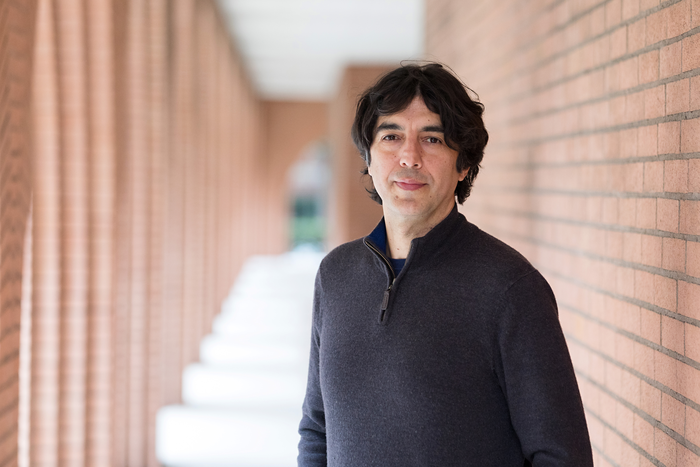Examining a range of research from studies in laboratory animals to epidemiological research in human populations gives scientists a clearer picture of what kind of nutrition can offer the best chance for a longer, healthier life, said USC Leonard Davis School of Gerontology Professor Valter Longo.

Credit: University of Southern California/Stephanie Kleinman
Examining a range of research from studies in laboratory animals to epidemiological research in human populations gives scientists a clearer picture of what kind of nutrition can offer the best chance for a longer, healthier life, said USC Leonard Davis School of Gerontology Professor Valter Longo.
In an article that includes a literature review published April 28 in Cell, Longo and coauthor Rozalyn Anderson of the University of Wisconsin describe the “longevity diet,” a multi-pillar approach based on studies of various aspects of diet, from food composition and calorie intake to the length and frequency of fasting periods.
“We explored the link between nutrients, fasting, genes, and longevity in short-lived species, and connected these links to clinical and epidemiological studies in primates and humans, including centenarians,” Longo said. “By adopting a multi-system and multi-pillar approach based on over a century of research, we can begin to define a longevity diet that represents a solid foundation for nutritional recommendation and for future research.”
What—and when—to eat for longevity
Longo and Anderson reviewed hundreds of studies on nutrition, diseases and longevity in laboratory animals and humans and combined them with their own studies on nutrients and aging. The analysis included popular diets such as the restriction of total calories, the high-fat and low-carbohydrate ketogenic diet, vegetarian and vegan diets, and the Mediterranean diet.
The article also included a review of different forms of fasting, including a short-term diet that mimics the body’s fasting response, intermittent fasting (frequent and short-term) and periodic fasting (two or more days of fasting or fasting-mimicking diets more than twice a month). In addition to examining lifespan data from epidemiological studies, the team linked these studies to specific dietary factors affecting several longevity-regulating genetic pathways shared by animals and humans that also affect markers for disease risk, including levels of insulin, C-reactive protein, insulin-like growth factor 1, and cholesterol.
The authors report that the key characteristics of the optimal diet appear to be moderate to high carbohydrate intake from non-refined sources, low but sufficient protein from largely plant-based sources, and enough plant-based fats to provide about 30 percent of energy needs. Ideally, the day’s meals would all occur within a window of 11-12 hours, allowing for a daily period of fasting, and a 5-day cycle of a fasting or fasting-mimicking diet every 3-4 months may also help reduce insulin resistance, blood pressure and other risk factors for individuals with increased disease risks, Longo added.
He described what eating for longevity could look like in real life: “Lots of legumes, whole grains, and vegetables; some fish; no red meat or processed meat and very low white meat; low sugar and refined grains; good levels of nuts and olive oil, and some dark chocolate.”
What’s next for the longevity diet
The next step in researching the longevity diet will be a 500-person study taking place in southern Italy, Longo said. The longevity diet bears both similarities and differences to the Mediterranean-style diets often seen in super-aging “Blue Zones,” including Sardinia, Italy; Okinawa, Japan; and Loma Linda, California. Common diets in these communities known for a high number of people age 100 or older are often largely plant-based or pescatarian and are relatively low in protein. But the longevity diet represents an evolution of these “centenarian diets,” Longo explained, citing the recommendation for limiting food consumption to 12 hours per day and having several short fasting periods every year.
In addition to the general characteristics, the longevity diet should be adapted to individuals based on sex, age, health status, and genetics, Longo noted. For instance, people over age 65 may need to increase protein in order to counter frailty and loss of lean body mass, as Longo’s own studies illustrated that higher protein amounts were better for people over 65 but not optimal for those under 65, he said.
For people who are looking to optimize their diet for longevity, he said it’s important to work with healthcare provider specialized in nutrition on personalizing a plan focusing on smaller changes that can be adopted for life, rather than big changes that will cause an harmful major loss of body fat and lean mass, followed by a regain of the fat lost, once the person abandons the very restrictive diet.
“The longevity diet is not a dietary restriction intended to only cause weight loss but a lifestyle focused on slowing aging, which can complement standard healthcare and, taken as a preventative measure, will aid in avoiding morbidity and sustaining health into advanced age,” he said.
The article, “Nutrition, longevity and disease: from molecular mechanisms to interventions,” was coauthored by Professor Rozalyn M. Anderson of the University of Wisconsin School of Medicine and Public Health. This work was supported in part by awards to Longo, including the Associazione Italiana per la Ricerca sul Cancro (IG#17605 and IG#21820.), the BC161452 grant of the Breast Cancer Research Program (US Department of Defense) and the National Institute on Aging-National Institutes of Health grants P01 AG055369. Anderson is supported by NIH-NIA RF1AG057408, R01AG067330, R01AG074503, Veterans Administration Merit Award BX003846, and by Impetus Grants and the Simons Foundation. This work was made possible by support from the William S. Middleton Memorial Veterans Hospital, Madison, Wisconsin.
Longo is the founder of and has an ownership interest in L-Nutra; the company’s food products are used in studies of the fasting-mimicking diet. Longo’s interest in L-Nutra was disclosed and managed per USC’s conflict-of-interest policies. USC has an ownership interest in L-Nutra and the potential to receive royalty payments from L-Nutra. USC’s financial interest in the company has been disclosed and managed under USC’s institutional conflict-of-interest policies.
Journal
Cell
DOI
10.1016/j.cell.2022.04.002
Method of Research
Meta-analysis
Subject of Research
People
Article Title
Nutrition, longevity and disease: from molecular mechanisms to interventions
Article Publication Date
28-Apr-2022
COI Statement
The article, “Nutrition, longevity and disease: from molecular mechanisms to interventions,” was coauthored by Professor Rozalyn M. Anderson of the University of Wisconsin School of Medicine and Public Health. This work was supported in part by awards to Longo, including the Associazione Italiana per la Ricerca sul Cancro (IG#17605 and IG#21820.), the BC161452 grant of the Breast Cancer Research Program (US Department of Defense) and the National Institute on Aging-National Institutes of Health grants P01 AG055369. Anderson is supported by NIH-NIA RF1AG057408, R01AG067330, R01AG074503, Veterans Administration Merit Award BX003846, and by Impetus Grants and the Simons Foundation. This work was made possible by support from the William S. Middleton Memorial Veterans Hospital, Madison, Wisconsin.
Longo is the founder of and has an ownership interest in L-Nutra; the company’s food products are used in studies of the fasting-mimicking diet. Longo’s interest in L-Nutra was disclosed and managed per USC’s conflict-of-interest policies. USC has an ownership interest in L-Nutra and the potential to receive royalty payments from L-Nutra. USC’s financial interest in the company has been disclosed and managed under USC’s institutional conflict-of-interest policies.




